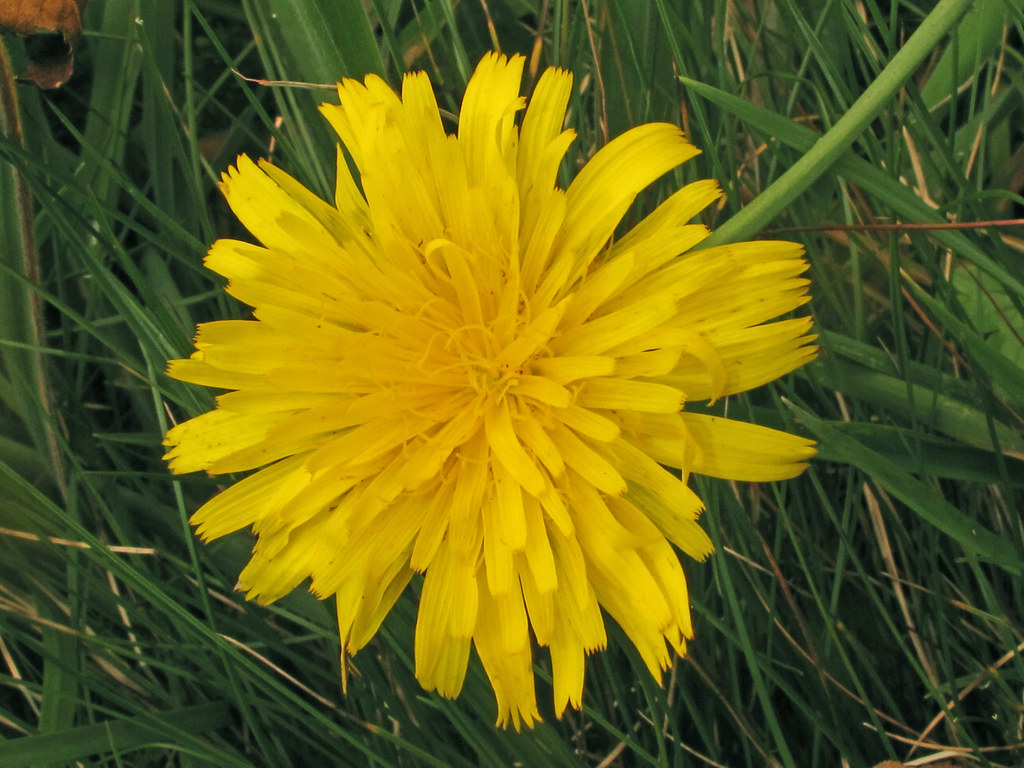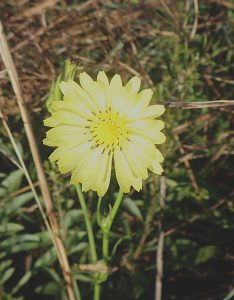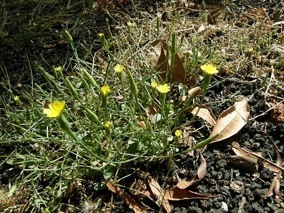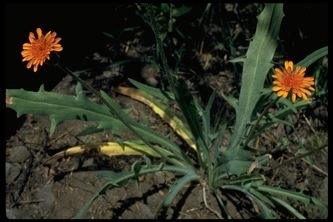
Pyrrhopapppaus carolinianus not a dandelion
Pyrrhopappus, & Hypochoeris: Are Dandelion Impostors
Most people don’t notice False Dandelions because they have the real thing. But here in the South where real dandelions are scarce and scraggly, False Dandelions stands out. Actually, they are found most of the Eastern US, and up the west coast. Let’s look at several of them starting with the Pyrrhopappus carolinianus.
P. carolinianus is not mentioned in any edible plant book I have. I learned about it from Dick Deuerling, author of “Florida’s Incredible Wild Edibles” which is still in print, the profits from which go to non-profit plant causes.
Dick, however, had a slightly different take on the False Dandelion. While ethnobotanical research shows the natives ate the roots, Dick preferred the leaves, raw in salads or cooked. The roots, by the way, are said to be much sweeter when picked in autumn. I use them just like Dandelion leaves, that is, young and tender leaves in a salad, older leaves boiled as a green. I learned from Suzanne Shires one can cook the stems and use like spaghetti.
Pyrrhopappus (pye-roh-PAP-pus) means “fire fluff” a reference to the floating dandelion-like seed. Carolinianus (kair-oh-lin-ee-AY-nus) means “of Carolina” which was an old way of saying middle America.

Hypochoeris radicata sometime call the Hairy Cat’s Ear. Photo by Green Deane
The second false dandelion is better known and more wide-spread. The Hypochoeris radicata (hye-poe-KÊ-ris rad-i-KAY-ta) is also called by several other names usually involving “cat’s ear” such as “Smooth Cat’s Ear” or “Spotted Cat’s Ear.” See pictures at right.
Unlike the previous “false dandelion” the radicata is an import from Europe. It is still very popular wild weed in France, Spain, Italy and Greece. It is one of only 17 plants that are still gathered by farming communities in those countries. You can find it in grassy areas and road sides. They can tolerate dry ground but like moist soil as well. In very wet conditions the rosette can grow in to a clump. On a sunny cay it covers my cousin’s lawn in South Carolina.
H. Radicata might be an acquired taste. Cooking reduces the bitterness but there is always left over bitterness, and the leaves are hairy as well. They can go in go raw in salads, or cooked in soups and also steam well. The “cat’s ear” part refers to the bitter hairy leaves. Radicata means “rooted.” Hypochoeris is translated to mean “for the hogs” because pigs like the roots. Another Hypochoeris, the glabra, right, is less bitter and is often eaten raw. Glabra means smooth, read hairless. Young tender stems of cat’s ear can be boiled and used like spaghetti.
Lastly a fourth false dandelion, also called the Mountain Dandelion, is the Agoseris aurantiaca, (a-go-SER-iss aw-ran-ti-AYE-kuh) below, found mostly in the western half of north America. It’s leaves were eaten by the Indians. Agoseris combines two Greek words, aego (goat) and seris (the genus name for a lettuce-like plant) and aurantiaca which means orange-red color.
Green Deane’s “Itemized” Plant Profile
IDENTIFICATION: On first glance you’ll think P. carolinianus is a dandelion but the flower’s rays are more sparse and you will see dark anthers in the middle area of the flower. The stem is thinner and stronger than a dandelion, and the leaves skinnier and far less intended. They tend to curl laterally towards the center.
H. radicata: first leaves are club-shaped, round end, and hairless, mature leaves grow to eight inches long. Leaves arranged in a basal rosette, hairy, toothed or irregularly lobed edges. Basal leaves obovate in shape and to 8 inches long and 1.5 inches wide with toothed edges that are deeply wavy. The basal leaves are very hairy and sessile (without stalks.) Leaves grow smaller up the stem, have a milk sap, leafless flower stalks with two to seven flowers on each stalk. H. glabra is similar to radicata but hairless.
Agoseris aurantiaca: Perennial with basal patch of long leaves, variable in shape but 15 inches in length, no stem, several flowers on tall peduncles up to two feet tall. Flower is ray florets with squared, toothed tips, deep orange to red, occasionally yellow, seed has dandelion-like tuff attached.
TIME OF YEAR: Same time as dandelions, greens spring and summer, roots in fall.
ENVIRONMENT: Same environment as dandelions, lawns, fields, common areas, sidewalk cracks. Prefers moist soil.
METHOD OF PREPARATION: P. carolinianus: Young leaves raw in salads, older leaves boiled like dandelions for a potherb, young stems like spavhetti. Autumn roots boiled or roasted. H. radicata, young leaves raw or cooked. H. glabra, leaves cooked or raw. Flower and buds of all can be used like dandelions. A. aurantiaca, cooked leaves




